BIO120 Second Term Test
1/155
There's no tags or description
Looks like no tags are added yet.
Name | Mastery | Learn | Test | Matching | Spaced |
|---|
No study sessions yet.
156 Terms
Lec 9: Evolutionary Processes and Large-Scale Evolution
- natural selection, genetic drift, mutation, gene-flow
(sources of microevolution)
-how does these processes explain macroevolution?
the species problem
the problem of how to define a species
many species concepts:
-taxonomic/morphological
-genetic
-biological
-etc
two main species concepts
1) taxonomic
-based on distinct measurable differences
2) biological
-based on inter-fertility among individuals
(concepts vary among organisms, no universal species concept)
Darwin and the origin of species
defined as a group of organisms that are sufficiently similar in phenotype
-he saw it as arbitrary
The biological species concept (BSC)
"a group of interbreeding natural populations that are reproductively isolated from other such groups" Ernst Mayr, 1942
-reproductive isolation as KEY to distinguishing species
-helps frame "the species problem"
Coyne and Orr
"When we understand the origin of reproductive isolating factors, we understand the origin of species" Coyne 1992
Points to Highlight about BSC
-focuses on the PROCESS
-geographic isolation alone is NOT sufficient
-reproductive isolation does NOT have to be absolute (but what is the cutoff?)
-members of same species must be interbreeding IN THE WILD
-does not apply well for bacteria, asexuals, selfers, or fossils
BSC is the concept used by most speciation researchers because of its focus on REPRODUCTIVE ISOLATION
Where does speciation occur? allopatric speciation
allopatric speciation much more common and easier to evolve, due to evolution with minimal gene flow
-often called geographic speciation
-due to involvement of geographic isolation
Where does speciation occur? sympatric speciation
sympatric speciation occurs within the same geographic area
-reproductive isolation from other factors
allopatric vs sympatric graph
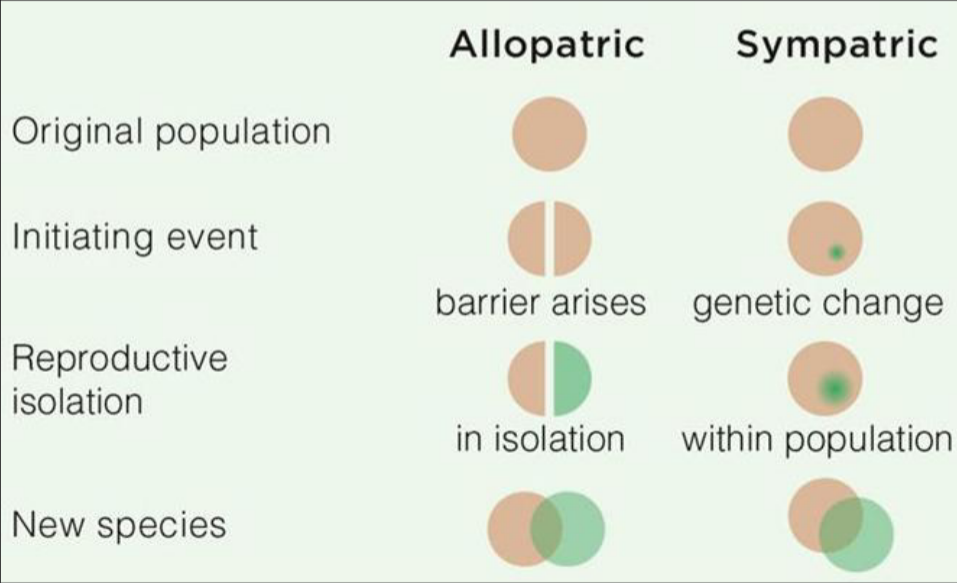
stages where reproductive isolation (RI) can occur
(Pre-zygotic)
finding a compatible mate and mating
fertilization
(Post-zygotic)
development and growth of zygote (F1)
adult survival and reproduction (F1)
growth, survival, reproduction of offspring (F2)
pre-zygotic RI barriers
preventing mating or fertilization (no zygote is formed)
-geographical, ecological
-temporal, behavioral (mate recognition)
-mechanical (genital structure compatibility)
-cellular (sperm-egg compatibility)
Pre-zygotic Isolation in Apple Maggot Flies: Habitat and Temporal Isolation
fly population used to be on hawthorns
-some of fly pop underwent a host shift after arrival of apples in 1800s
different timing of host plant fruiting (apple vs hawthorn)
-different timing of fly mating on preferred host plant
-gene flow reduced by 94% in sympatry (same region)
Pre-zygotic Isolation in Abalone
binding of sperm lysin protein to egg vitelline envelope receptor (VERL) is required for fertilization
-molecular "lock and key"
lysin/VERL has coevolved
-different evolutionary changes in different species
-causes reproductive isolation due to fertilization incompatibility
Post-zygotic RI barriers
post zygotic barriers prevent proper functioning of zygotes once they are formed
/
-caused by combination of low-fitness genes in the hybrid
-arise as an indirect byproduct of evolution acting separately in different popuations
/
intrinsic post-zygotic barriers: inherent genetic problems
-inviability, sterility, or abnormal development of hybrids
/
extrinsic post-zygotic barriers:
-ecological mismatch of hybrid phenotype to environment
(i.e. sterility or lethality)
Mules and Hinny: An Example of Intrinsic Post-zygotic Isolation
Mule is a sterile hybrid cross of:
-male donkey (62 chromosomes)
-female horse (64 chromosomes)
Hinny is a sterile hybrid of:
-Male horse (64 chromosomes)
-Female donkey (62 chromosomes)
Relation Between Genetic Distance and Post-zygotic Isolation in Fruit Flies
-the more that fly pairs are genetically differentiated, more likely to be reproductively isolated
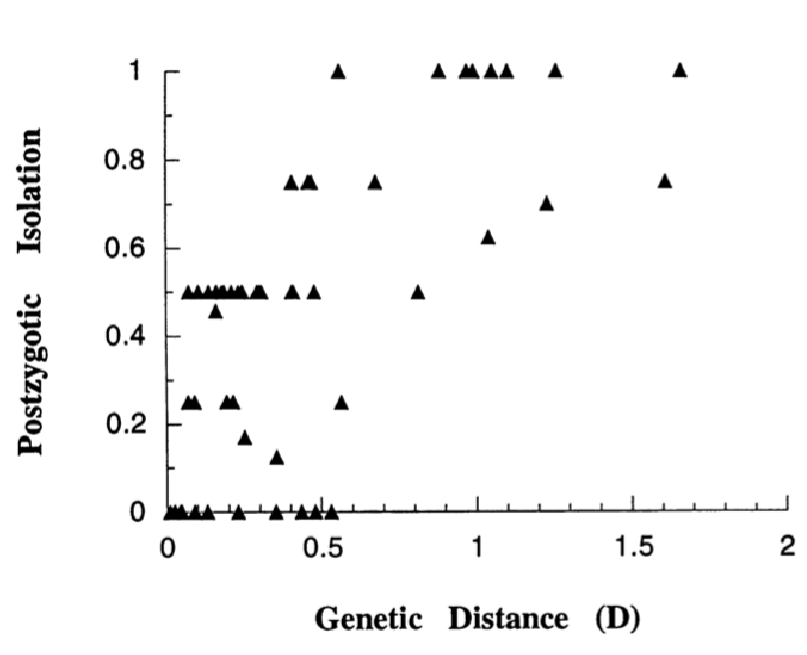
Extrinsic Post-zygotic Isolation: Poorly Adapted Hybrids
e.g. Aposematic Heliconius Butterflies
-hybrids have aberrant colour patterns
-higher predation ----> lower mating success

Is adaptive evolution required for speciation? ecological speciation
local adaptation can lead to reproductive isolation (RI) and speciation
-distinct evolutionary responses to different selective pressures
-local adaptation not absolutely necessary
-but accelerates population divergence and evolution of RI
/
termed: ecological speciation
/
much current research aims to determine
-biotic and abiotic agents
-underlying 'speciation genes'
ecological speciation: benthic vs limnetic sticklebacks
-marine sticklebacks colonized coastal freshwater lakes
-2 morphs evolved, differ ecologically and morphologically
benthic: prefer lake bottoms, eat large invertebrates, have deep bodies and wide mouths
limnetic: live in open water, eat zooplankton, have slender bodies and narrow mouths
evolution has contributed to RI:
-hybrids have lower fitness in each habitat
-females prefer males of own morph
adaptive radiation
(rapid diversification of a single ancestral species into multiple new species that are adapted to different ecological niches)
the evolution of ecological and phenotypic diversity within a rapidly multiplying lineage
-originates from single common ancestor
-process results in array of many species
-the species differ in traits allowing exploitation of a range of habitats and resources
“/”
four features commonly identify an adaptive radiation:
1) recent common ancestry from single species
2) phenotype-environment correlation
3) trait utility
4) rapid speciation
What causes adaptive radiations?
1) ecological opportunity - absence (or reduction) of competition for resources
- colonization of competition-free regions (e.g. Galapagos finches, East African cichlids)
- extinction of competitors (mammals radiation after extinction of dinos)
-key innovation: evolution of a trait that provides access to new resources (anole lizards radiation after evolving toepads)
2) high propensity for speciation
-RI evolves more readily in some clades than others (e.g. finches vs mockingbirds)
hybridization - opposite of speciation
the exchange of genes between species as result to inter-species mating
-sometimes can reverse speciation process to merge two groups into one
varies across tree of life
common in plants and fish, rare in mammals
can result in complex patterns in variation
can be evolutionarily significant for speciation, especially by polyploidy
polyploidy
describes an organism, tissue, or cell with more than two complete sets of chromosomes
allopolyploidy: BETWEEN species
arises from duplicated karyotype following hybridization
most common type
autopolyploidy: WITHIN species
arises from duplicated karyotype
e.g. non-disjunction
Hybridization to Form an Allopolyploid
1. two species mate and produce F1 hybrid offspring
2. F1 hybrid produces unreduced diploid gametes due to meiotic non-disjunction
3. diploid gametes combine to produce tetraploid F2 offspring
4. tetraploid is fertile, but is reproductively isolated from parental species
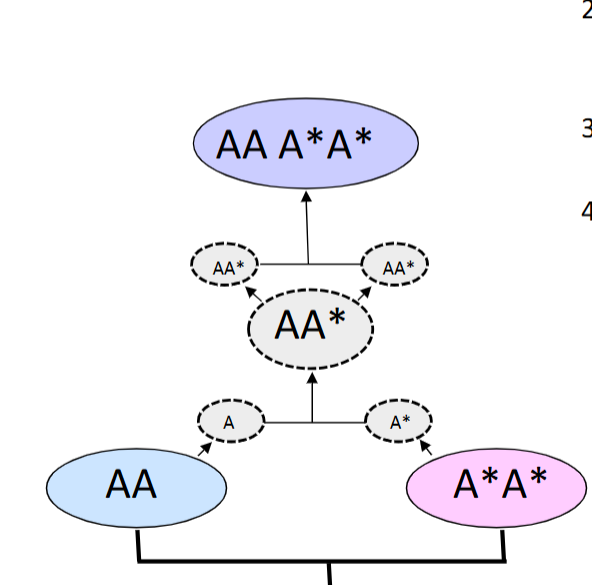
evolutionary significance of polyploidy
1) Polyploids reproductively isolated from their diploid parents: a form of sympatric speciation
2) Polyploids exhibit novel phenotypes: allows exploitation of new habitats
3) Hybrid vigour evident due to heterozygosity, particularly in allopolyploids
4) Approximately half of all flowering plants are of polyploid origin including many crops plants & invasive species
Lec 10: phylogenetics and macroevolution
-taxonomy and systematics
-understanding phylogenies
-how to reconstruct phylogenies
-macroevolution: understanding large-scale evolutionary patterns and processes
Taxonomy
the theory and practice of classification and naming
in modern practice, taxonomic names are assigned such that they are consistent with our present understanding of evolutionary relationships
systematics
the study of biodiversity and the evolutionary relationships among organisms
carolus linnaeus (1707-1778) pre-evolution
-father of taxonomy
-binomial nomenclature
-hierarchal system of classification
-taxon: a single named taxonomic unit at any level (plural: taxa)
kingdom, phylum, class, order, family, genus, species
What is the Purpose of a Biological Classification?
- a name is key to shared info of an organism
- has predictive power
- enables interpretation of origins and evolutionary history
systematics research REQUIRES a robust and stable system for classifying organisms
Phylogenies are evolutionary histories of species
A. individual organisms within a pop
B. parents produce offspring
C. lines of descent persist across generations
D. a population is an aggregation of the genetic lineages of the individuals they contain
E. a species is made of many populations, linked by gene flow
F. individual species split to give rise to multiple species
G. a phylogeny shows the relationships and evolutionary histories of species

components of a phylogenetic tree: nodes
nodes correspond to historical lineage splitting events, when one lineage splits into two
components of a phylogenetic tree: branches
branches correspond to single ancestor-descent lineages
-all branches connected by nodes
components of a phylogenetic tree: tips (terminals)
tips do not have represented descendants
can be:
-individuals
-species
-clades (many species)
components of a phylogenetic tree: internal vs external branches
external branches (terminal branches) connect tip and a node
internal branches connect two nodes (historical)
components of a phylogenetic tree: sister group (sister taxa)
Sister taxa are those that are the immediate descendants of the same ancestor
Examples include "sister species", "sister branches", "sister clades"
components of a phylogenetic tree: parents and daughters
parent branches give rise to daughter branches
components of a phylogenetic tree: root
a node representing earliest time point on the diagram
often represented by an unlabeled branch
components of a phylogenetic tree: ingroup and outgroup
the ingroup consists of the focal species in a phylogenetic study
the outgroup is a more distant relative of the ingroup taxa
-can help root the phylogeny and help determine ancestral traits
components of a phylogenetic tree: MRCA
The MRCA (most recent common ancestor) is the youngest node that is ancestral to all lineages in a given group of taxa
components of a phylogenetic tree: clade
any piece of a phylogeny that INCLUDES an MRCA and all of its descendants
any piece of a phylogeny that exhibits monophyly
a tree can contain many clades
grouping concepts: monophyly
describes a group made of an ancestor and all of its descendants
- "monophyletic group" or "clade"
passes the 'scissor test' (one cut removes all of the group)
grouping concepts: paraphyly
describes a group made up of an ancestor and some (but not all) of its descendants
-"paraphyletic group" or "grade"
does not pass the 'scissor test'
grouping concepts: polyphyly
describes a group that does not contain the MRCA of all members
-"polyphyletic group"
does not pass the 'scissor test'
phylogenies and trait evolution (aka character evolution)
Ancestral vs Derived
-terms refer to inheritance of traits for a given group of species
-does NOT describe species themselves
-For the species in a clade, a trait is "ancestral" if it was inherited from the MCRA of the clade
-A trait is "derived" for that clade if it originated within the clade (e.g. in a descendant of the clade's MRCA)
>>>the same trait can be ancestral for a clade but derived within a larger clade
synapomorphy
a shared, derived trait for a clade
all species in the clade share
evolved on the branch leading to the clade
homology
similar structures observed in different taxa can be traced to structure present in shared evolutionary ancestor
Homoplasy
when a character or character state arises more than once on a phylogenetic tree
-similar but not from same evolutionary origin
-convergence is one kind (similar environment)
why conduct phylogenetic analysis?
- Understand history of life
- Understand large-scale patterns of evolution
- Understand how many times traits have evolved, how fast, under what conditions
- Practical: where/when did parasites spread? Which flu strain was the most successful last year? what drives mutations in SARS-COV-2?
Reconstructing Phylogenies
there is only ONE phylogenetic history of earth (but how do we figure out?)
1. ignore all characters present in just 1 species
2. what patterns of relatedness are indicated by shared, derived traits?
3. nested relationships can be illustrated using a bifurcating graph
tada!!!
Notes About Phylogeny Reconstruction
Modern phylogenetic methods fit models of evolution to observed trait data
Trait data can be genetic or phenotypic
Phylogenetic relatedness is inferred from homologous traits
Homoplasy (e.g., convergent trait evolution) can mislead phylogenetic inference
(DNA sequencing has enabled rapid progress towards constructing the tree of life)
Macroevolution is the study of evolutionary processes and patterns among species
2 principal sources of macroevolutionary insights:
-paleontology=
>>>direct record of past
>>>inference is strongest for groups that fossilize well
-phylogenetics=
>>>indirect record of past
>>>inference is strongest for groups that have living representatives
Mass Extinctions Periodically Restructure Life on Earth: fossils
Mass extinction: extinction of >75% of earth's species in a short period
fossil record:
-provides our only evidence for completely extinct clades
-documents long-term patterns of global biodiversity
-provides evidence for mass extinctions
Mass Extinctions Periodically Restructure Life on Earth: phylogenetics
-provides evidence for explosive diversification following mass extinctions
-diversification rate: speciation rate minus extinction rate
Other Features Associated With Increased Diversification
-herbivory
-more sexual selection
-animal pollination in plants
-increased dispersal and range size
Lec 11: the evolution of complexity
the complexity of a biological system reflects the number of parts it has
-prokaryote vs eukaryote
-unicellular vs multicellular
hierarchy:
-macromolecule
-cell
-tissue
-organ & organ systems
-organism
the tree of life
the tree of life has diversity in both simple and complex organisms
bacteria and archaea are simpler
eukaryotes are typically more complex in cell number, tissue types, physiology, etc
Major Transitions in Evolution
seeks to understand major changes in organizations of life
hypothesis: greater complexity arises from greater 'cooperation' among previously independent units
unit of selection
selection acts at many specific levels of biological organization when the three criteria is met:
-variation
-heritability
-differential fitness
selection can occur at ANY level if these criteria is met
-individual, species, cells, genes
Gene's Eye View
because genes are the unit of inheritance, ultimately the target of selection is the gene
multi-level selection poses a problem with complexity
selection at a given level of organization means that units compete to maximize fitness
competition in lower-level units of organization may reduce fitness at higher levels
e.g. cancer
cooperation
if lower-level units cooperate rather than compete, higher-level fitness costs can be avoided
how to biological subunits stay cooperative?
many features of individual organisms prevent competition WITHIN an individual
ensures that many genes succeed by enhancing the fitness of the individual
mitosis and meiosis
mitosis ensures alleles dont compete within an individual
meiosis ensures fair representation of gene variants from each parent among daughter cells (Aa ---> 50% A, 50% a)
development and multicellularity
starting from single cell prevents initial competition among cell lineages
breakdown of cooperation: cheating a fair meiosis (MEIOTIC DRIVE)
meiotic drive: an allele can bias its own transmission
the allele can spread to higher frequency
even if it reduces individual fitness
'selfish' element
(Aa ---> 2% A, 98% a)
excess heterozygotes or homozygotes for the preferred allele
meiotic drive can rapidly eliminate alleles that have higher individual fitness
Meiotic Drive: Cheating Mendel's Law of Segregation (Drosophila example)
ss X Ss ---> 95-99% Ss
-'S' allele has transmission bias, meiotic drive
-'S' allele prevents proper 's' sperm formation
evolutionary response to cheating meiotic drive
-strong selection to repress cheating
-favor counteracting 'restorer' alleles are at other genes to silence biased alleles
Breakdown of Cooperation: Cheating a Fair Meiosis (OVER-REPLICATION)
transposable elements (TEs) are self-replicating segments of DNA
TE replication separated from cellular replication
ensure their own over-representation in offspring
can replicate and insert itself into other parts of the genome
TEs can make up over 50% of DNA in genomes of some species
1/3 of human genome is selfish DNA (yikes!)
How Do Genomes Not 'Explode' From Transposition?
1) alleles arising elsewhere in genome that silence TEs will be favoured
mechanisms controlling DNA and histone methylation
piRNAs and RNA interference may have evolved as silencing mechanisms
2) transposition-selection balance
transposition is a form of mutation that can disrupt a gene
OPPOSING
natural selection against harmful effects on the organism reduces abundance of chromosome copies with most TEs
abundance of TEs in an organism results from a balance between these opposing forces
how do individual genomes stay so cooperative?
many features of individual organisms ensure that the variance in fitness WITHIN an individual is minimized
ensures that many genes succeed by enhancing the fitness of the organism ('group')
BUT: countless ways to evade cooperation
presence of strong selection on rest of genome ('policing') seems essential to maintain higher-level cohesion
How do collections of cells stay cooperative?
1) staring from single cell reduces competition within individuals
2) separation of germline with limited numbers of cell divisions inhibits transmission of selfish cell lineages (less mutation)
3) tumor suppressors and other features inhibit unregulated cell division
.
BUT: somatic mutation is inevitable in long-lived multicellular organisms
some mutations may be selectively favored WITHIN an organism
cancer: Selfish Cell Lineages Evolving Within an Individual
spreads commonly in tissue that is relatively undifferentiated
-evolves resistance to treatment/immune system
illustrates the 'short sightedness' of the evolutionary process
Lec 12: pests and evolution, the problem
we use chemicals to combat pests and pathogens
-including weeds, insects, bacteria, tumors
we create strong selective pressure for resistance
-fitness advantage to resistant genotypes arising from mutation and gene flow
can we design an 'evolution-proof' solution? if so, how?
Weeds and Agriculture: A Major Problem
weeds cause 34% loss of crop yields annually
-26 bil losses
-usual fix: spray with herbicides
weeds have repeatedly evolved resistance to many types of herbicides
Spread of Glyphosate Resistance in Ontario Fleabane
-most regions have resistant weeds
-glyphosate herbicide used to be really effective until resistance evolved
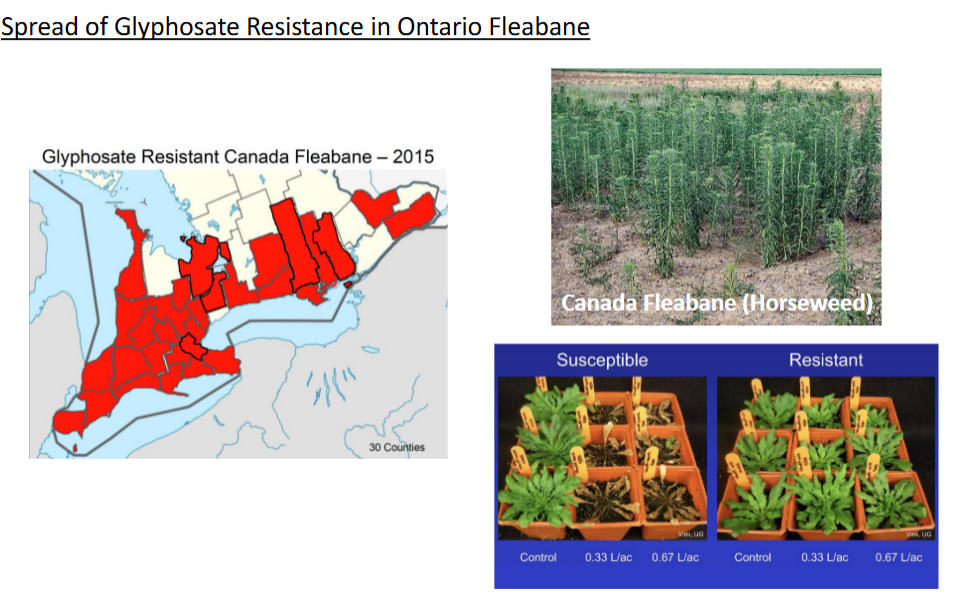
Where Does Resistance Come From?
1) Pre-existing genetic variation in the population
2) New mutations: in very large populations new, simple mutations may be introduced at a high rate
3) Gene flow: 'Epidemic spread' of resistance from one region to the next
.
wisest management strategy depends on how resistance tends to evolve
outcrossing weeds have more pre-existing resistance variation than selfing weeds
Evolution of Herbicide Resistance in Waterhemp
-looked at genetic composition in waterhemp populations
-resistance evolves through: pre-existing variation, long-distance dispersal and new mutation
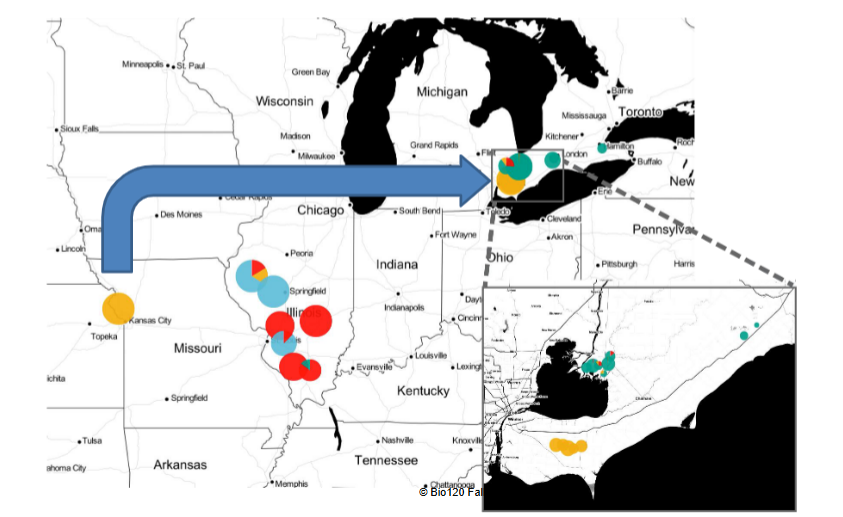
Can Herbicide Resistance Be Stopped?
1. multi-herbicide treatment:
makes new adaptation less likely
requires more complex adaptation
.
2. rotation of different kinds of herbicides:
weeds regularly hit by different selection pressures
BUT: could select for generalized resistance
evolutionary rescue
Evolutionary rescue is a process by which a population—that would have gone extinct in the absence of evolution—persists due to natural selection acting on heritable variation
-we hope weeds do not have rescue
-we hope endangered species do
Malaria and mosquitoes
-malaria causes over 600,000 deaths annually
-major prevention strategy is insecticides
-strong selective pressure on mosquitoes has led to rapid evolution of resistance
"Evolution-Proof" Solutions to mosquitoes?
Tailor insecticide application to knowledge of mosquito generation times & spatial distributions
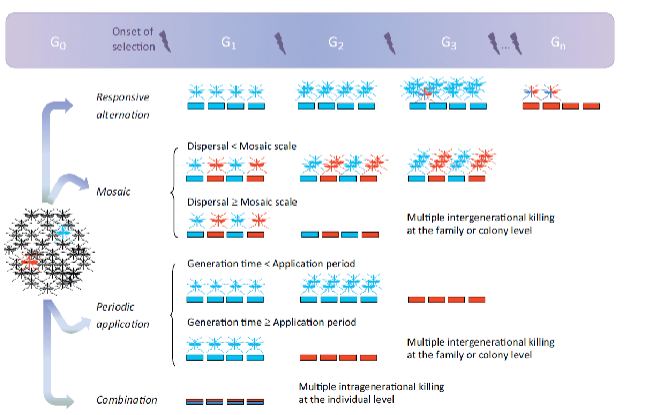
Evolution in Medicine: malarial drug
less aggressive drug treatment of malaria (in mice) resulted in:
-less evolution
-reduced infectiousness
-similar health outcomes
Evolutionary Strategies for Management of HIV
current HIV drugs hinder virus replication, but cannot eradicate virus from latent reservoirs in the body
thus, we use evolution to manage HIV rather than eliminate it
.
multi-drug cocktail:
single mutations unlikely to confer resistance to multiple drugs with different mechanisms of action
lower viral loads make multiple mutations less likely
.
evolutionary toggling:
once resistance evolves, stop taking drug
resistance has a cost, so non-resistant forms will then dominate
then re-apply drug, reducing virus levels
Cancer Treatment Also Selects for Drug-Resistant Tumors
Strong, prolonged selection pressures using the same chemotherapy drugs
- May not be the best solution
- Selects for resistance
Cycling drugs, multidrug cocktails, lower doses of drugs
- A better option?
- Ethical considerations make tests of theory for human application challenging
The Problem: Humans Are Causing Rapid Environmental Change
loss or fragmentation of habitat
.
altered abiotic condition
(temp, precipitation, pH, salinity, chemical pollutants)
.
altered biotic composition
(transport of species, invasive species and diseases)
Genetic issues in conservation biology
• Loss of genetic diversity
• Loss of heterozygosity
• Inbreeding depression
• Fixation of deleterious alleles
• Inability of populations to adapt
Probability of Evolutionary Rescue From Adaptation
Depends on:
• Population size
• Beneficial mutation rate
• How much fitness was reduced
Lec 13: Ecology is the science of
how organisms interact with each other and with their environment
the distribution and abundance of species
the structure and function of ecosystems
.
THE SCIENCE OF BIODIVERSITY
Nothing in biology makes sense except in the light of evolution
Nothing in evolution makes sense except in the light of ecology
"The Ecological Theater and the Evolutionary Play"
Title of a book by Hutchinson (1965)
• Ecology is the setting where evolution plays out
• Interactions between organisms and their environment give rise to natural selection
Endosymbiotic theory for the origin of mitochondria - MARGULIS
eukaryotic cells evolved from a larger host cell engulfing smaller prokaryotic cells
.
"life did not take over the globe by combat, but by networking"
symbiosis
A relationship in which two different organisms live in close association with each other
mutualism
A relationship between two species in which both species benefit
DEVILS GARDEN FINISH - ignore
how many species are there?
too many
more than 85% still unknown to science
one estimate, extrapolated from rates at which new taxa are described: 8.7 million (just eukaryotes, plus/minus 1 million)
.
Biodiversity is not equally distributed across the tree of life
70-90% of all species are bacteria
model vs non-model organisms
model:
-lab mice (mus musculus) ---> vertebrates
-fruit fly (drosophila melanogaster) ---> insects
-arabidopsis thaliana ---> plants
non-model:
-everything else
population
population is all the individuals of the SAME species in one place at one time
community
An ecological community is ALL the species living together in one place at one time
Ecosystem
An ecosystem is ALL the species PLUS the non-living environment
species range
Species have ranges of tolerance along environmental gradients
lethal zones —> survival —> growth —> reproduction
.
important factors that determine whether a species can or cannot live in an area is limiting factors
two most likely:
conditions: temp
resources: water
(weather/climate)
what determines where species live?
Dispersal
Abiotic conditions - Climate, Nutrients
Species interactions - Competition, Predation, Mutualism
.
these factors vary across space and time; see it as Gradients of conditions
organisms perform best at certain portions of a gradient
what determines abundance? - MALTHUS
Malthus's essay stated that the size of a population cannot grow faster than the resources that support it
-struggle for existence